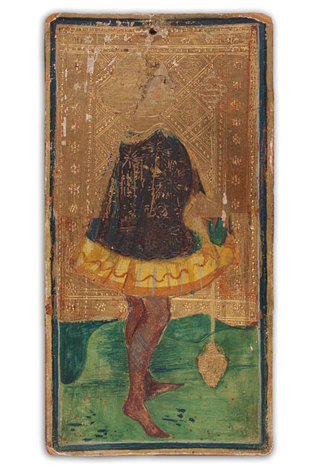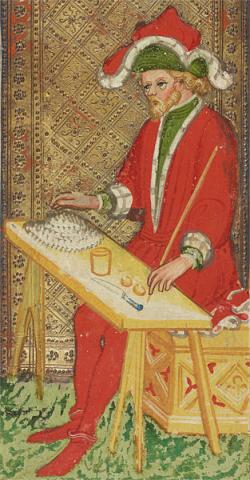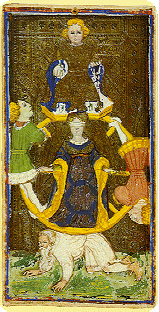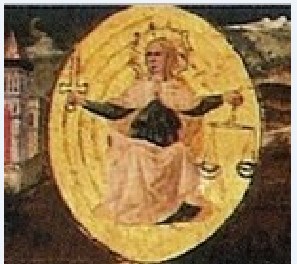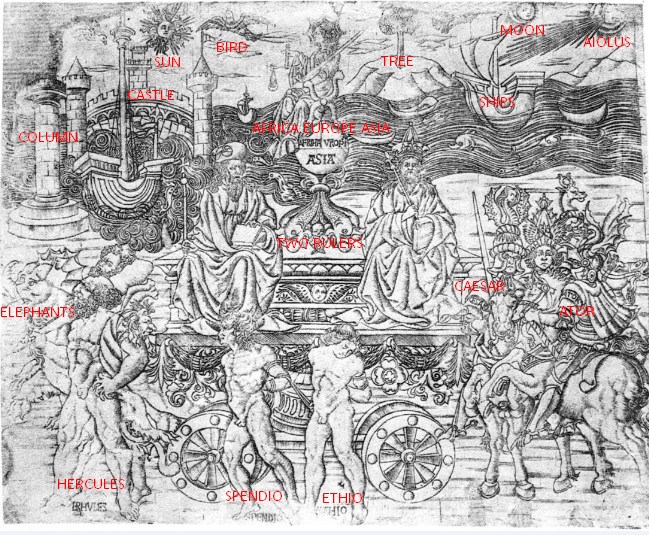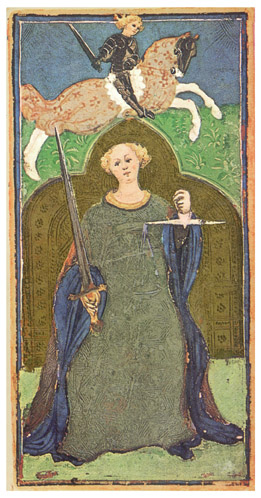Franco Pratesi asked recently ...
"Given the 6 triumphs of Petrarch, how could they be expanded up to the 22 ones of the tarot pack?"
A rather good question. The 14 trumps of the first painter of the PMB were once (at the start) sorted (according my opinion) ...
1 Magician (with 4 symbols on the table)
-----------
2 Popess
3 Empress
4 Emperor
5 Pope
-----------
-----------
6 Love (1st Trionfo of Petrarca)
7 Chariot with woman = Chastity (traditionally accompanied by virtues; 2nd Trionfo of Petrarca)
8 NEW: Justice = Fame (4th Trionfo of Petrarca)
9 Father Time (Trionfo of Petrarca)
-----------
10 Fortune (with 4 persons)
11 Fool
12 Traitor
13 Death (3rd Trionfo of Petrarca; finishes individual life)
14 NEW; Judgment = Eternity (6th Trionfo of Petrarca; finishes global life)
****************
This arrangement would make sense ... all six Petrarca motifs would have been part of the arrangement. And it's simple, and simple means nice and suggestive
Well everybody would recognize the card Justice in the PMB as Justice, not as fame ... at least at first sight. But the problem of the first 14 trumps is, that Justice is the only one virtue in this deck, no other is present. That's a sort of contradiction. The second artist later added 6 virtues, but some of the virtues were transformed.
Fortitudo is given.
Temperance is given.
Prudentia is hidden behind world.
Sun-Moon-Star replace the 3 theological virtues.
This action could be justified by the condition, that the virtues accompanied Chastity (in the Petrarca text)
*************
Michael J. Hurst has once done a great work to collect pictures of the Petrarca Trionfi at wikipedia.
http://commons.wikimedia.org/wiki/Petrarch%27s_triumphs
This makes it easy to look for anything, which connects Fame to Justice (or, what makes Fame look like Justice). It's there, but it's not one of the common motifs. Which doesn't mean much, as there were a lot of variations for Fame.
... it's taken from this:
https://commons.wikimedia.org/wiki/Petr ... 1465-2.jpg
... with the comment
"Triumphs of Fame, Time, and Eternity
Attributed to Domenico di Zanobi. - Scanned from Virtù d'amore. Pittura nuziale nel Quattrocento fiorentino."
A second "Justice as Fame":
... it's taken from this:
Full picture:
https://commons.wikimedia.org/wiki/Cate ... orence.jpg
... with the comment:
"Illustration of Petrarch's Triumph of Fame, oddly depicted as Justice with sword and scales.
The artist is unknown. - Scanned from Von Bartsch: The Illustrated Bartsch, v.24."
Found at ...
https://commons.wikimedia.org/wiki/Cate ... f_Petrarch#/
... I found also the other 5 pictures of the series.
https://commons.wikimedia.org/wiki/Cate ... orence.jpg
https://commons.wikimedia.org/wiki/Cate ... orence.jpg
https://commons.wikimedia.org/wiki/Cate ... orence.jpg
https://commons.wikimedia.org/wiki/Cate ... orence.jpg
https://commons.wikimedia.org/wiki/Cate ... orence.jpg
Further I found this collection of "Fame" ... 50 pictures
https://commons.wikimedia.org/wiki/Cate ... ph_of_Fame#
Love ... 43 pictures
https://commons.wikimedia.org/wiki/Cate ... ph_of_Love#
Chastity ... 36 pictures
https://commons.wikimedia.org/wiki/Cate ... f_chastity
Death ... 32 pictures
https://commons.wikimedia.org/wiki/Cate ... h_of_Death#
Time ... 35 pictures
https://commons.wikimedia.org/wiki/Cate ... ph_of_Time#
Eternity ... 26 pictures
https://commons.wikimedia.org/wiki/Cate ... f_Eternity#
I don't know, if this all goes back to Michael J. Hurst, anyway I observed earlier, that he was working on this. Maybe he found some followers, and that's very good.
Fame has 50 pictures, but a greater part is double or more than twice, so maybe there are 35 motifs only. 2 of them has "Justice as Fame". I found 6 of this following type, Fame with an archer on her left hand (and a sword in her right mostly):
Another larger group shows Fame victorious against death. Another Fame with 2 trumpets. A good part are single motifs, which don't belong to a category. So 2 of 35 might be not so bad for "Justice as Fame".
I attempted to analyze this second "Justice as Fame" ...
I had luck and could identify "Spendio" as "Spendios"
https://fr.wikipedia.org/wiki/Spendios and thereby repair "Ethio" as "Matho" or "Mathos"
https://fr.wikipedia.org/wiki/Mathos , both active in the first Punic war (both captives of Fame). Herkules and Caesar are clear, for "Ator" I can only suspect the Egyptian god with this name. As the Punic war had been a fight between Europe and Africa, and Caesar had been in Egypt, indicating another war between Europe and Africa, and Asia - Europe - Africa are otherwise given as a theme of the picture, Ator might be a plausible solution. The true political aim might be a new crusade, likely not against Africa, but against the Ottomans, the place, where one could gain the highest fame. The two rulers might be the contemporary pope and emperor ... or whoever.
Aiolus (god of the winds) was a standard attribute to Fame, cause one needs some air to blow the trumpet. The elephants are another standard attribute. The castle (perhaps Jerusalem ?) is somehow also indicated at the Cary-Yale Fame. A column was produced in 1452, when the emperor Fredrick III visited Italy and married. The form of the island with tree and cliffs remembers me on PMB and Sforza heraldry, strange enough. But generally I would assume, that the work is of a later date.
Alright, I think, that one should look at this card ...
... as a presentation of Fame, at least, if one assumes, that after so much talking the 5x14-theory has something to say.
******************
Well, the theme is opened.
Franco Pratesi meanwhile has published his relevant article (for which he has asked the question: "Given the 6 triumphs of Petrarch, how could they be expanded up to the 22 ones of the tarot pack?")
1450ca: Trionfi e Triumphi
http://www.naibi.net/A/521-PETRAR-Z.pdf
The 5x14-deck lies between 6 motifs (Petrarca's poem) and 22 motifs (Tarocchi pack), so it doesn't give a complete answer to the question. Naturally.


